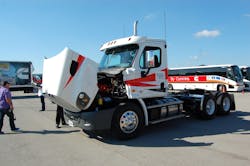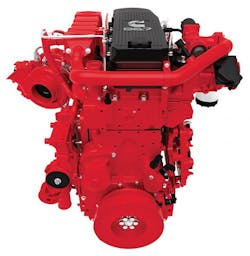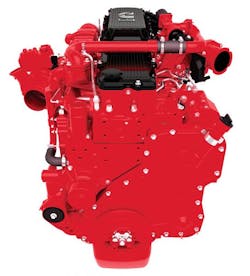Cummins B6.7 and L9 engines can now burn paraffinic diesel
Engine maker Cummins Inc. announced that its B6.7 and L9 engine platforms, along with its B4.5 engine, are now compatible with “paraffinic renewable diesel fuels” meeting the EN 15940 specification.
That means operators of Cummins-powered trucks and buses are required to source all paraffinic fuels from high-purity suppliers meeting EN 15940, as this ensures that the fuel contains the necessary lubricity additive for use in a diesel engine.
Compared with conventional fossil-based diesel, paraffinic diesel fuels offer the potential to reduce greenhouse gas (GHG) emissions by 40% to 90% over the total life cycle of the vehicle, the engine maker said.
The OEM noted that paraffinic diesel fuels can be used as a 100% substitute for standard EN 590 or ASTM D975 ultra-low sulfur diesel (ULSD) without requiring any change to the Cummins engine.
For example, no additional engine maintenance is required when using paraffinic fuels meeting the EN 15940 specification, and the same fuel filters are retained.
Cummins added that paraffinic diesel can easily be blended with standard diesel at varying percentages, including winter-grade fuels, and has the same stability and cold properties as conventional diesel, which means it can be used and stored in the same ways.
The engine maker said it led an 18-month field trial using 100% paraffinic diesel fuel in order to understand changes in engine performance, aftertreatment effects and fuel system durability.
Engine performance remained stable and consistent while using the paraffinic fuel, and customers should not expect to see any differences, the company noted.
Depending on the application and the engine duty cycle, a fuel economy detriment of 0% to 6% is expected due to the lower density of paraffinic fuels compared with regular diesel fuel.
Yet Cummins pointed out that a thorough analysis of the aftertreatment system showed that each subsystem – the diesel oxidation catalyst (DOC), diesel particulate filter (DPF) and selective catalytic reduction (SCR) device – remained stable throughout the test with performance similar to that of regular diesel fuel.
The materials in the fuel system equipment (O-rings, injectors and pumps) are all compatible with EN 15940 diesel fuels, the engine maker stressed.
Other light-duty, heavy-duty and high-horsepower platforms are currently undergoing a similar validation plan on 100% paraffinic fuels, and Cummins will be announcing the results of the studies throughout 2017.
"Focused on energy diversity and enabling the power of choice, Cummins has provided another approved fuel option to help the continued reduction of emissions,” added Jim Fier, vice president of engineering at Cummins, in a statement
“The use of paraffinic diesel allows customers to minimize their emissions-based footprints without additional capital investment," he said.
Cummins approval for the use of renewable diesel with B6.7 and L9 engines aligns with the recent introduction of EN 15940, a final European CEN specification for paraffinic diesel fuels, including hydrotreated vegetable oil (HVO), gas-to-liquids (GTL) and biomass-to-liquids (BTL).
About the Author
Sean Kilcarr
Editor in Chief
Sean Kilcarr is a former longtime FleetOwner senior editor who wrote for the publication from 2000 to 2018. He served as editor-in-chief from 2017 to 2018.


